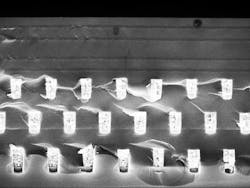Super-Planckian photonic material exhibits LED-like light when heated
Ordinarily, no object at a given temperature can emit more radiation than a blackbody at that temperature. However, a tungsten-based photonic crystal created by Shawn Yu Lin, a professor of physics at Rensselaer Polytechnic Institute (Troy, NY), defies the limits of Planck’s law, emits light with an intensity of eight times greater than a blackbody reference when heated to 600 K, as described in two technical papers.1, 2 The emission is narrowband light similar to that produced by lasers or LEDs, but without the semiconductor structure. The material structure shows a spike in radiation at about 1.7 μm, which is the near-infrared portion of the electromagnetic spectrum.
RELATED: Tailored emissivity paves way for 400 lm/W incandescent lamps
“These two papers offer the most convincing evidence of ‘super-Planckian’ radiation in the far-field,” says Lin. “This doesn’t violate Planck’s law. It’s a new way to generate thermal emission, a new underlying principle. This material, and the method that it represents, opens a new path to realize superintense, tunable LED-like infrared emitters for thermophotovoltaics and efficient energy applications.”
For his research, Lin built a three-dimensional tungsten photonic crystal in a configuration similar to a diamond crystal, that narrows the spectral output to about 1 μm. The structure is in an optical cavity that further narrows the bandwidth to roughly 0.07 μm. Lin has been working to establish this advance for 17 years, since he created the first all-metallic photonic crystal in 2002, and the two papers represent the most rigorous tests he has conducted.
In both the imaging and spectroscopy study, Lin prepared his sample and a blackbody control, which consisted of a coating of vertically aligned nanotubes on top of the material, side by side on a single piece of silicon substrate, eliminating the possibility of changes between testing the sample and control that could compromise the results. In an experimental vacuum chamber, the sample and control were heated to 600 K.
In Nature Scientific Reports, Lin presents spectral analysis taken in five positions as the aperture of an infrared spectrometer moves from a view filled with the blackbody to one of the material. Peak emission, with an intensity of 8 times greater than the blackbody reference, occurs at 1.7 μm.
The IEEE Photonics Journal paper presented images taken with a near-infrared conventional CCD camera.
Super-Planckian radiation in the far-field
Recent unrelated research has shown a similar effect at a distance of less than 2 thermal wavelengths from the sample, but Lin’s is the first material to display super-Planckian radiation when measured from 30 cm away (about 200,000 wavelengths) in the far-field.
Although theory does not fully explain the effect, Lin hypothesizes that the offsets between the layers of photonic crystal allow light to emerge from within the many spaces inside the crystal. The emitted light bounces back and forth within the confines of the crystal structure, altering the property of the light as it travels to the surface to meet the optical cavity.
“We believe the light is coming from within the crystal, but there are so many planes within the structure, so many surfaces acting as oscillators, so much excitation, that it behaves almost like an artificial laser material,” Lin says. “It’s just not a conventional surface.”
The new material could be used in applications like energy harvesting, military IR-based object tracking and identification, producing high-efficiency optical sources in the IR driven by waste heat or local heaters, research requiring environmental and atmospheric and chemical spectroscopy in the IR, and in optical physics as a laserlike thermal emitter.
Source: https://news.rpi.edu/content/2020/03/23/advanced-%e2%80%9csuper-planckian%e2%80%9d-material-exhibits-led-light-when-heated
REFERENCE:
1. Shawn-Yu Lin et al., Nature Scientific Reports (2020); https://doi.org/10.1038/s41598-020-62063-2.
2. Shawn-Yu Lin et al., IEEE Photonics Journal (2019); doi: 10.1109/JPHOT.2019.2948995.
About the Author
John Wallace
Senior Technical Editor (1998-2022)
John Wallace was with Laser Focus World for nearly 25 years, retiring in late June 2022. He obtained a bachelor's degree in mechanical engineering and physics at Rutgers University and a master's in optical engineering at the University of Rochester. Before becoming an editor, John worked as an engineer at RCA, Exxon, Eastman Kodak, and GCA Corporation.

